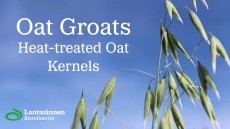Rising meat, grain prices put squeeze on supply chains
grain and meat prices will put the squeeze on plant managers to
find ways to cut costs out of their supply chains.
Grain prices in particular have surged over the past year with US wheat export prices up by 30 per cent and maize by about 67 per cent, according to the latest commodity forecast report by the European Commission. Processors have already been dealing with higher packaging and energy costs. The additional hit from their commodity supplies serves as a triple blow to plant operations, which have been under pressure from management to become more efficient as margins decline. The higher commodity costs have been due to extreme weather patterns, the higher demand from the biofuels industry and low stocks. In Australia drought cut grain crops by more than half. Smaller crops were also recorded in the EU, US, Canada and Ukraine. Global maize and wheat stocks are at historically low levels and should remain low over the projection period, according to the report. This factor has left processors scrambling to secure their supply source, no matter what the price. However relief should be in sigh, the Commission says, forecasting that farmers will respond to the higher prices by increasing production over the 2007 to 2008 growing season. Most international organisations are expecting continued annual growth in production and consumption of 1.2 per to 1.4 per cent, driven by feed demand and increasing industrial use. The global stocks to use ratio of maize was just 12 per cent in the 2006 to 2007 growing season and is forecast to remain low, the Commission reported. However by 2009 the biofuel industry is expected to consume about 30 per cent of the maize crop. Higher prices point to a 10-percentage point drop in feed use, to 40 per cent to 50 per cent of the crop. The EU is the largest wheat producer and consumer in the world. The bloc's net exports are expected to rise, as production grows faster than consumption. Vegetable oils will continue to be the fastest growing sector within the oilseeds segment with growth especially strong in developing countries, boosted by rising population and income growth, the report stated. With strong demand, prices should increase by about 50 per cent over the next ten years, the Commission stated, quoting US estimates. Last year the Organisation for Economic Cooperation and Development and the Food and Agriculture Organisation anticipated an increase in oilseed prices of about 20 per cent. Although the EU will continue to rank behind China and India as a net-importer, its trade deficit in vegetable oils increases, mainly in palm oil. Malaysian palm oil exports to the EU have tripled in the last five years, the report stated. High rapeseed oil prices have increased demand for lower priced soya oil, mainly sourced from Brazil. In 2006 the EU switched from being a net exporter of soya oil to a net importer, as processors searched for alternate sources. Sugar was one of the few commodities which saw prices collapse last year. Sugar prices fell by 25 per cent due to a cut in EU support measures, among other fators. The market had been expecting a global sugar deficit for the 2005 to 2006 growing season, which never materialised, despite the cut in EU production. As it turned out the gap left by the EU was more than offset by expansion in Brazil, India and elsewhere. Meanwhile prices and supply sourcing in the meats sector was mixed in 2006. Pigmeat prices fell by about 10 per cent in 2006, due largely to oversupply in the market. Poultry prices also fell by about 10 per cent, due to avian flu. Trade was also affected with a significant drop in imports into the EU and Russia. As a result, prices fell sharply in the US and Brazil, the top exporters, the Commission reported. In the beef segment prices held steady last year. US and Brazilian exports continued to be constrained by animal disease problems, while Argentina imposed a partial ban on exports as an inflation control measure. According to a US government agency, world trade in meat fell by 2 per cent in 2006, reflecting some adjustments to higher feed costs, particularly in the pig and poultry sectors. Poultry remains the fastest growing sector. Prices are expected to rise by 12 per cent to 14 per cent, according to US estimates. Beef and veal consumption and production is expected to grow steadily by up to 1.9 per cent, largely because of growing demand in Asia. Exports could grow sharply by about 15 per cent to 30 per cent by the end of the projection period, according to the US estimates. The Food and Agricultural Policy Research Institute expects beef prices to stay at their current relatively high level, which is 14 per cent above the average of the past decade. Brazil is the world's largest beef exporter and is expected to gain world market share, with exports increasing as the country recovers from the foot and mouth disease outbreak of October 2005. The EU is expected to continue to be a net importer of meat. The US, currently facing export problems due to BSE, is forecast to resume beef exports to Asian markets. By 2015, China is expected to come close to the USA or Brazil in terms of beef production. Both consumption and production are projected to grow by 5 per cent annually, the report stated.





















